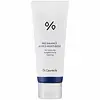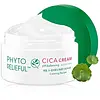What's inside
What's inside
 Key Ingredients
Key Ingredients

 Benefits
Benefits

 Concerns
Concerns

No concerns
 Ingredients Side-by-side
Ingredients Side-by-side

Water
Skin ConditioningGlycerin
HumectantCaprylic/Capric Triglyceride
MaskingSorbitan Stearate
Emulsifying1,2-Hexanediol
Skin ConditioningCetearyl Alcohol
EmollientGlyceryl Stearate
EmollientCyclohexasiloxane
EmollientLaminaria Japonica Extract
Skin ProtectingEclipta Prostrata Leaf Extract
Skin ConditioningCentella Asiatica Extract
CleansingFicus Carica Fruit Extract
HumectantCitrus Aurantium Dulcis Oil
MaskingHydrogenated Lecithin
EmulsifyingCitrus Nobilis Peel Oil
MaskingLitsea Cubeba Fruit Oil
MaskingPalmitic Acid
EmollientBisabolol
MaskingStearic Acid
CleansingCarbomer
Emulsion StabilisingButylene Glycol
HumectantTromethamine
BufferingLactobacillus Ferment
Skin ConditioningXanthan Gum
EmulsifyingFructooligosaccharides
HumectantTrisodium EDTA
Beta-Glucan
Skin ConditioningAdenosine
Skin ConditioningPanthenol
Skin ConditioningMyristic Acid
CleansingHydrolyzed Hyaluronic Acid
HumectantRaffinose
Skin ConditioningFolic Acid
Skin ConditioningLactobacillus Ferment Lysate
Skin ConditioningLactococcus Ferment Lysate
Skin ConditioningBifida Ferment Filtrate
Skin ConditioningBifida Ferment Lysate
Skin ConditioningSaccharomyces Ferment Filtrate
HumectantCeramide NP
Skin ConditioningCholesterol
EmollientTheanine
EmollientMilk Lipids
Skin ConditioningGlutathione
Palmitoyl Pentapeptide-4
Skin ConditioningEthylhexylglycerin
Skin ConditioningWater, Glycerin, Caprylic/Capric Triglyceride, Sorbitan Stearate, 1,2-Hexanediol, Cetearyl Alcohol, Glyceryl Stearate, Cyclohexasiloxane, Laminaria Japonica Extract, Eclipta Prostrata Leaf Extract, Centella Asiatica Extract, Ficus Carica Fruit Extract, Citrus Aurantium Dulcis Oil, Hydrogenated Lecithin, Citrus Nobilis Peel Oil, Litsea Cubeba Fruit Oil, Palmitic Acid, Bisabolol, Stearic Acid, Carbomer, Butylene Glycol, Tromethamine, Lactobacillus Ferment, Xanthan Gum, Fructooligosaccharides, Trisodium EDTA, Beta-Glucan, Adenosine, Panthenol, Myristic Acid, Hydrolyzed Hyaluronic Acid, Raffinose, Folic Acid, Lactobacillus Ferment Lysate, Lactococcus Ferment Lysate, Bifida Ferment Filtrate, Bifida Ferment Lysate, Saccharomyces Ferment Filtrate, Ceramide NP, Cholesterol, Theanine, Milk Lipids, Glutathione, Palmitoyl Pentapeptide-4, Ethylhexylglycerin
Water
Skin ConditioningGlycerin
HumectantDicaprylyl Ether
EmollientPanthenol
Skin Conditioning1,2-Hexanediol
Skin ConditioningHexyldecyl Laurate
EmollientHexyldecanol
EmollientDipropylene Glycol
HumectantEclipta Prostrata Leaf Extract
Skin ConditioningLaminaria Japonica Extract
Skin ProtectingButylene Glycol
HumectantHydroxyacetophenone
AntioxidantTromethamine
BufferingCentella Asiatica Extract
CleansingEthylhexylglycerin
Skin ConditioningHydrogenated Lecithin
EmulsifyingPolyquaternium-51
Skin ConditioningFructooligosaccharides
HumectantXanthan Gum
EmulsifyingBeta-Glucan
Skin ConditioningFicus Carica Fruit Extract
HumectantSolanum Melongena Fruit Extract
Skin ConditioningAmmonium Acryloyldimethyltaurate/Vp Copolymer
Carbomer
Emulsion StabilisingHydrolyzed Hyaluronic Acid
HumectantLonicera Japonica Flower Extract
Skin ConditioningForsythia Suspensa Fruit Extract
AntioxidantCnidium Officinale Root Extract
Skin ConditioningCoptis Japonica Root Extract
Skin ConditioningGardenia Jasminoides Fruit Extract
Cosmetic ColorantAngelica Gigas Root Extract
Skin ConditioningHouttuynia Cordata Extract
Skin ConditioningGlycyrrhiza Uralensis Root Extract
Skin ConditioningCeramide NP
Skin ConditioningTocopherol
AntioxidantPentylene Glycol
Skin ConditioningWater, Glycerin, Dicaprylyl Ether, Panthenol, 1,2-Hexanediol, Hexyldecyl Laurate, Hexyldecanol, Dipropylene Glycol, Eclipta Prostrata Leaf Extract, Laminaria Japonica Extract, Butylene Glycol, Hydroxyacetophenone, Tromethamine, Centella Asiatica Extract, Ethylhexylglycerin, Hydrogenated Lecithin, Polyquaternium-51, Fructooligosaccharides, Xanthan Gum, Beta-Glucan, Ficus Carica Fruit Extract, Solanum Melongena Fruit Extract, Ammonium Acryloyldimethyltaurate/Vp Copolymer, Carbomer, Hydrolyzed Hyaluronic Acid, Lonicera Japonica Flower Extract, Forsythia Suspensa Fruit Extract, Cnidium Officinale Root Extract, Coptis Japonica Root Extract, Gardenia Jasminoides Fruit Extract, Angelica Gigas Root Extract, Houttuynia Cordata Extract, Glycyrrhiza Uralensis Root Extract, Ceramide NP, Tocopherol, Pentylene Glycol
 Reviews
Reviews

Ingredients Explained
These ingredients are found in both products.
Ingredients higher up in an ingredient list are typically present in a larger amount.
1,2-Hexanediol is a synthetic liquid and another multi-functional powerhouse.
It is a:
- Humectant, drawing moisture into the skin
- Emollient, helping to soften skin
- Solvent, dispersing and stabilizing formulas
- Preservative booster, enhancing the antimicrobial activity of other preservatives
Beta-Glucan is a polysaccharide. It can be derived from the cell walls of seaweed, oats, yeast, and fungi. It hydrates the skin and helps boost your skin's natural barrier.
As an antioxidant, beta-glucan helps fight free-radicals. Free-radicals are molecules that may damage your skin cells, such as pollution.
Studies show this ingredient may be an effective wrinkle reducer as it can deeply penetrate into skin. It has also been show to help with wound healing.
Learn more about Beta-GlucanButylene Glycol (or BG) is used within cosmetic products for a few different reasons:
Overall, Butylene Glycol is a safe and well-rounded ingredient that works well with other ingredients.
Though this ingredient works well with most skin types, some people with sensitive skin may experience a reaction such as allergic rashes, closed comedones, or itchiness.
Learn more about Butylene GlycolCarbomer is a polymer of acrylic acid. Its main role is to create a gel consistency.
A high amount of carbomer can cause pilling or balling up of products. Don't worry, most products contain 1% or less of carbomer.
Centella Asiatica Extract (Centella) is derived from an herb native to Southeast Asia. It is famous for its anti-inflammatory and soothing properties.
Centella is rich in antioxidants and amino acids, such as Madecassic Acid and Asiaticoside.
Studies show the compounds in centella help with:
The combination of all these properties makes centella effective at soothing, hydrating, and protecting the skin.
Other great components of centella include Vitamin A, vitamin C, several B vitamins, and Asiatic Acid.
Fun fact: Centella has been used as a medicine and in food for many centuries. As a medicine, it is used to treat burns, scratches, and wounds.
Learn more about Centella Asiatica ExtractCeramide NP is a type of ceramide and formally known as ceramide 3.
Ceramides are intercellular lipids naturally found in our skin that bonds dead skin cells together to create a barrier. They are known for their ability to hold water and thus are a great ingredient for dry skin.
Ceramides are an important building block for our skin barrier. A stronger barrier helps the skin look more firm and hydrated. By bolstering the skin ceramides act as a barrier against irritating ingredients. This can help with inflammation as well.
If you would like to eat ceramides, sweet potatoes contain a small amount.
Read more about other common types of ceramides here:
Ceramide AP
Ceramide EOP
Eclipta Prostrata Leaf Extract comes from the false daisy plant. False daisy contains antioxidant compounds such as flavonoids.
One study found false daisy to absorb UVA and UVB radiation. However, this should not replace your sunscreen.
False daisy is used in both traditional medicines and foods throughout Southeast Asia and India.
Learn more about Eclipta Prostrata Leaf ExtractEthylhexylglycerin (we can't pronounce this either) is commonly used as a preservative and skin softener. It is derived from glyceryl.
You might see Ethylhexylglycerin often paired with other preservatives such as phenoxyethanol. Ethylhexylglycerin has been found to increase the effectiveness of these other preservatives.
Ficus Carica Fruit Extract comes from the fruit known as the fig. Figs are rich in antioxidants and helps hydrate the skin.
Figs also contain fatty acids and Vitamins A, B1, and B2.
As a humectant, figs are able to draw moisture from the air to your skin. This helps keep your skin hydrated.
Learn more about Ficus Carica Fruit ExtractFructooligosaccharides is an alternative sweetener. It is often derived from the blue agave plant.
This ingredient is a prebiotic and helps to hydrate the skin. Emerging studies are also showing fructooligosaccharides to have antioxidant properties.
As a humectant, Fructooligosaccharides helps draw moisture to the skin, helping to hydrate the skin.
Bananas, onions, garlic, asparagus, jícama, and leeks also contain fructooligosaccharides.
Learn more about FructooligosaccharidesGlycerin is already naturally found in your skin. It helps moisturize and protect your skin.
A study from 2016 found glycerin to be more effective as a humectant than AHAs and hyaluronic acid.
As a humectant, it helps the skin stay hydrated by pulling moisture to your skin. The low molecular weight of glycerin allows it to pull moisture into the deeper layers of your skin.
Hydrated skin improves your skin barrier; Your skin barrier helps protect against irritants and bacteria.
Glycerin has also been found to have antimicrobial and antiviral properties. Due to these properties, glycerin is often used in wound and burn treatments.
In cosmetics, glycerin is usually derived from plants such as soybean or palm. However, it can also be sourced from animals, such as tallow or animal fat.
This ingredient is organic, colorless, odorless, and non-toxic.
Glycerin is the name for this ingredient in American English. British English uses Glycerol/Glycerine.
Learn more about GlycerinHydrogenated Lecithin is created from the hydrogenation of lecithin (a group of phospholipids). Hydrogenation is a chemical reaction between hydrogen and another element.
This ingredient is an emollient and emulsifier. As an emollient, it helps soften skin by trapping moisture within. As an emulsifier, it prevents oil and water ingredients from separating.
Hydrolyzed Hyaluronic Acid is a form of hyaluronic acid. It is created by the hydrolysis of hyaluronic acid with a high molecular weight. Once created, Hydrolyzed Hyaluronic Acid has a low molecular weight.
Low molecular weight HA has been shown to hydrate and increase elasticity of the skin. Increasing elasticity is also associated with reduction of wrinkle depth.
One study found topical low molecular weight hyaluronic acid may be considered for the treatment of rosacea in the adult population. However, we always recommend speaking with a professional about your skin concerns.
Hyaluronic acids are a humectant. This means they draw moisture from the air. Hyaluronic acids help moisturize, soothe, and protect the skin.
Read more about other common forms of hyaluronic acid:
Learn more about Hydrolyzed Hyaluronic AcidLaminaria Japonica Extract comes from a kelp more commonly known as 'sweet kelp'. It is commonly eaten in Japan, Korea, and China.
Sweet kelp is a humectant and helps hydrate your skin. Humectants draw moisture from the air to your skin.
Studies show Laminaria Japonica has antioxidant compounds. Antioxidants may help with anti-aging. Kelp also contains magnesium and zinc, making it great for calming inflammation and redness.
Learn more about Laminaria Japonica ExtractPanthenol is a common ingredient that helps hydrate and soothe the skin. It is found naturally in our skin and hair.
There are two forms of panthenol: D and L.
D-panthenol is also known as dexpanthenol. Most cosmetics use dexpanthenol or a mixture of D and L-panthenol.
Panthenol is famous due to its ability to go deeper into the skin's layers. Using this ingredient has numerous pros (and no cons):
Like hyaluronic acid, panthenol is a humectant. Humectants are able to bind and hold large amounts of water to keep skin hydrated.
This ingredient works well for wound healing. It works by increasing tissue in the wound and helps close open wounds.
Once oxidized, panthenol converts to pantothenic acid. Panthothenic acid is found in all living cells.
This ingredient is also referred to as pro-vitamin B5.
Learn more about PanthenolTromethamine helps balance the pH and improve the texture of a product. It is synthetically created.
As an emulsifier, Tromethamine prevents oil and water ingredients from separating. This helps stabilize the product and elongate a product's shelf life. Tromethamine also makes a product thicker.
Tromethamine helps balance the pH level of a product. Normal pH level of skin is slightly acidic (~4.75-5.5). The acidity of our skin is maintained by our glands and skin biome. Being slightly acidic allows our skin to create an "acid mantle". This acid mantle is a thin barrier that protects our skin from bacteria and contaminants.
Oral Tromethanmine is an anti-inflammatory drug but plays the role of masking, adding fragrance, and/or balancing pH in skincare.
1,3-Propanediol, 2-amino-2-(hydroxymethyl)-
Learn more about TromethamineWater. It's the most common cosmetic ingredient of all. You'll usually see it at the top of ingredient lists, meaning that it makes up the largest part of the product.
So why is it so popular? Water most often acts as a solvent - this means that it helps dissolve other ingredients into the formulation.
You'll also recognize water as that liquid we all need to stay alive. If you see this, drink a glass of water. Stay hydrated!
Learn more about WaterXanthan gum is used as a stabilizer and thickener within cosmetic products. It helps give products a sticky, thick feeling - preventing them from being too runny.
On the technical side of things, xanthan gum is a polysaccharide - a combination consisting of multiple sugar molecules bonded together.
Xanthan gum is a pretty common and great ingredient. It is a natural, non-toxic, non-irritating ingredient that is also commonly used in food products.
Learn more about Xanthan Gum